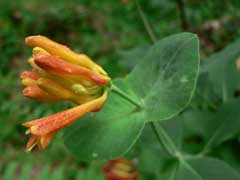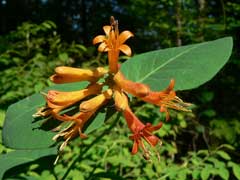 |
|
http://en.wikipedia.org/wiki/User_talk:Wsiegmund |
 |
| http://en.wikipedia.org/wiki/User_talk:Wsiegmund |
Translate this page:
Summary
Physical Characteristics

 Lonicera ciliosa is an evergreen Climber growing to 10 m (32ft 10in) at a medium rate.
Lonicera ciliosa is an evergreen Climber growing to 10 m (32ft 10in) at a medium rate.
See above for USDA hardiness. It is hardy to UK zone 5. It is in leaf all year, in flower in June, and the seeds ripen in August. The species is hermaphrodite (has both male and female organs) and is pollinated by Insects.
Suitable for: light (sandy), medium (loamy) and heavy (clay) soils. Suitable pH: mildly acid, neutral and basic (mildly alkaline) soils. It can grow in semi-shade (light woodland) or no shade. It prefers moist soil.
UK Hardiness Map
US Hardiness Map
Synonyms
L. ciliosa occidentalis. L. occidentalis. Caprifolium ciliosum. C. occidentale.
Plant Habitats
Woodland Garden Dappled Shade; Shady Edge;
Edible Uses
Edible Parts: Fruit Nectar
Edible Uses:
Fruit - raw or cooked[105, 177, 212]. Not tasty enough to be widely sought[212]. The fruit is about 5mm in diameter[200]. Children enjoy sucking the nectar from the base of the flowers[256, 257].
References More on Edible Uses
Medicinal Uses
Plants For A Future can not take any responsibility for any adverse effects from the use of plants. Always seek advice from a professional before using a plant medicinally.
Contraceptive Epilepsy Miscellany Poultice TB Women's complaints
The leaves are contraceptive and tonic[257]. An infusion has been used as a contraceptive and also as a treatment for problems in the womb[257]. A decoction has been used in the treatment of colds and tuberculosis[257]. A poultice of the chewed leaves has been applied to bruises[257]. An infusion of the woody part of the plant has been drunk in small amounts, or used as a bath, in the treatment of epilepsy[257].
References More on Medicinal Uses
The Bookshop: Edible Plant Books
Our Latest books on Perennial Plants For Food Forests and Permaculture Gardens in paperback or digital formats.

Edible Tropical Plants
Food Forest Plants for Hotter Conditions: 250+ Plants For Tropical Food Forests & Permaculture Gardens.
More

Edible Temperate Plants
Plants for Your Food Forest: 500 Plants for Temperate Food Forests & Permaculture Gardens.
More

More Books
PFAF have eight books available in paperback and digital formats. Browse the shop for more information.
Shop Now
Other Uses
Fibre Hair Miscellany
An infusion of the stems is used as a hair shampoo and tonic to make it grow[99, 257]. A fibre obtained from the stem is used in making mats, bags, blankets etc[99]. The stems were used as building materials by the native North American Indians. They were used with willow withes to reinforce suspension bridges across canyons and rivers. They were also twisted with coyote willow to lash together the framing poles of underground pit houses and to make a pliable ladder[257].
Special Uses
References More on Other Uses
Cultivation details
Prefers a good loamy soil and cool moist conditions at the roots[11, 200]. Succeeds in partial shade[200]. Subject to attacks by aphis, especially in hot dry spells[11]. Climbs by twining around other plants[182].
References Carbon Farming Information and Carbon Sequestration Information
Temperature Converter
Type a value in the Celsius field to convert the value to Fahrenheit:
Fahrenheit:
The PFAF Bookshop
Plants For A Future have a number of books available in paperback and digital form. Book titles include Edible Plants, Edible Perennials, Edible Trees,Edible Shrubs, Woodland Gardening, and Temperate Food Forest Plants. Our new book is Food Forest Plants For Hotter Conditions (Tropical and Sub-Tropical).
Shop Now
Plant Propagation
Seed - best sown as soon as it is ripe in a cold frame. Stored seed requires 2 months cold stratification[113] and should be sown as soon as possible in a cold frame. When they are large enough to handle, prick the seedlings out into individual pots and grow them on in the greenhouse for at least their first winter. Plant them out into their permanent positions in late spring or early summer, after the last expected frosts. Cuttings of half-ripe wood, 7 - 10cm with or without a heel, July/August in a frame. Good percentage[78]. Cuttings of mature wood of the current season's growth, 15 - 20cm with or without a heel, November in a cold frame. Good percentage[78]. Layering in autumn[200].
Other Names
If available other names are mentioned here
Native Range
NORTHERN AMERICA: Canada (British Columbia (southwest)), United States (Idaho (north), Montana (west), Oregon, Washington, California (north))
Weed Potential
Right plant wrong place. We are currently updating this section.
Please note that a plant may be invasive in one area but may not in your area so it's worth checking.
Conservation Status
IUCN Red List of Threatened Plants Status :

Growth: S = slow M = medium F = fast. Soil: L = light (sandy) M = medium H = heavy (clay). pH: A = acid N = neutral B = basic (alkaline). Shade: F = full shade S = semi-shade N = no shade. Moisture: D = dry M = Moist We = wet Wa = water.
Now available:
Food Forest Plants for Mediterranean Conditions
350+ Perennial Plants For Mediterranean and Drier Food Forests and Permaculture Gardens.
[Paperback and eBook]
This is the third in Plants For A Future's series of plant guides for food forests tailored to
specific climate zones. Following volumes on temperate and tropical ecosystems, this book focuses
on species suited to Mediterranean conditions—regions with hot, dry summers and cool, wet winters,
often facing the added challenge of climate change.
Read More
Expert comment
Author
(Pursh.)Poir.
Botanical References
1160200
Links / References
For a list of references used on this page please go here
Readers comment
| Add a comment |
|
If you have important information about this plant that may help other users please add a comment or link below. Only comments or links that are felt to be directly relevant to a plant will be included. If you think a comment/link or information contained on this page is inaccurate or misleading we would welcome your feedback at [email protected]. If you have questions about a plant please use the Forum on this website as we do not have the resources to answer questions ourselves.
* Please note: the comments by website users are not necessarily those held by PFAF and may give misleading or inaccurate information.
To leave a comment please Register or login here All comments need to be approved so will not appear immediately.
|
Subject : Lonicera ciliosa
|
|
|
|